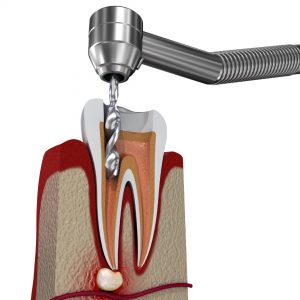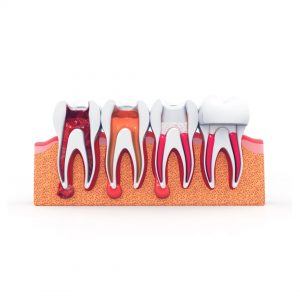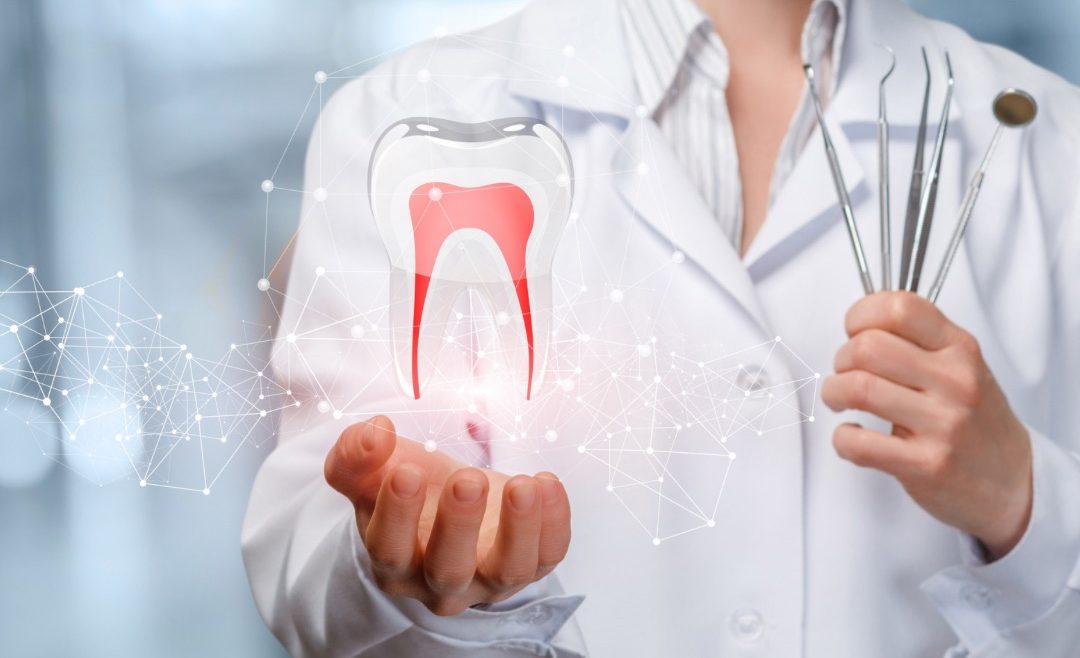- What is endodontic treatment?
Endodontic treatment is a procedure for treating the root canals of the tooth, where most of the time due to untimely repair of a carious lesion or traumatic injuries to the tooth, an infection of the tissue inside the root canals occurs.
- What are the signs that indicate the need for endodontic treatment?
– Sensitivity to cold or heat
– Pain while chewing
– Swelling
– Tooth discoloration
– Constant pain, which can spread to the face, ear, opposite jaw or other teeth
Sometimes even in the absence of pain, there may be an infection of the root canals that we determine through routine X-rays and clinical tests. In that case, we indicate the need for endodontic treatment.
- Is the root canal treatment a painful and unpleasant procedure?

Many patients have unpleasant experiences with endodontic treatment and based on those experiences they would rather extract the tooth than save it. With modern technology, the treatment is painless and the discomfort associated with endodontic treatment is minimized, which encourages patients to still opt for endodontic treatment and keep the tooth in their mouth.
- How many visits are needed for root canal treatment?
Usually, by some standards, root canal treatment is completed in three visits. But it is still a matter of biological tissue, which can react differently in different patients. In some cases, additional visits may be needed. We are proud to have complete and state-of-the-art equipment with which we can perform a complete mechanical root treatment even in just one visit. This is justified to be done in certain carefully selected cases.
- What is mechanical endodontics?
This method of root canal treatment is a faster, more precise, more thorough and more detailed method of root canal treatment. It is performed with special devices that are guided and controlled by the dentist. Those devices use very flexible and at the same time very powerful canal treatment tools that allow reaching certain parts of the canals that are very difficult or impossible to access with manual treatment. In this method, larger masses of the infected tissue of the canal are more reliably removed and the infection that was the cause of the initial problem is better controlled. Doctors at Dental Art use magnifiers to increase the working field in order to have greater visibility and precision of what they are doing. Also, in this method, very intensive agents are used, which chemically contribute to destroying the causative agent and sterilizing the canals. In order to protect the patient from all unwanted moments during the therapy, we use a Cofferdam system that does not allow any mechanical or chemical element to be in contact with the living tissues of the patient.
- How will I know if the tooth has been properly treated?
During the procedure and after the completion of each step of the procedure, X-rays are taken to check and confirm the achieved result. X-ray is the fastest and most reliable method to check success.
- Treating a tooth with mechanical endodontics or extracting that tooth?
Preserving your natural tooth, whenever possible, is the best option, because nothing can completely replace it. Your teeth are stronger and function more naturally. Keeping your natural teeth preserves the natural structure of the mouth and jaw, which also affects normal chewing function and speech. One of the benefits of your natural teeth is the preservation of aesthetics, facial appearance and natural smile. Even though at the moment it seems that root canal treatment is a long procedure, in the long run it is more financially profitable and less invasive compared to tooth extraction. If the tooth is extracted, in order to maintain normal aesthetics and function, the empty space should be supplemented with a prosthetic or implant.
- How best to protect an endodontically treated tooth further?

In addition to good endodontic treatment, for a long-term good prognosis of the same and further success, the appropriate restoration is also very important. When a tooth has lost much of its tooth structure, it loses its strength. There are two ways to replace lost tooth structure after endodontic treatment, with a filling or a crown. In general, with greater loss of tooth structure, a crown is considered a better option, as it is stronger and lasts longer than a large filling.
- Why is it most often advised to put a root restoration on the treated canals?
Very often, when cleaning the carious lesion in an endodontically treated tooth, a large amount of dental substance is lost, in such cases it is necessary to place a root restoration. A fiberglass post is placed in the already cleaned and filled channels. Its function is to ensure the strength of the endodontically treated tooth, that is, to serve as its pillar and to ensure that the remaining coronal structure is firmly connected to the root part. Most often, a crown is placed on such teeth.
- What is laser root canal sterilization?
It is an additional tool in the root canal treatment procedure. Namely, if we understand the procedure as a 5-step procedure: removal of the infected tissue, mechanical cleaning of the canals, chemical rinsing and medicament treatment, laser sterilization comes as a crown at the end, which, with the help of the laser beam inside the canal, completely sterilizes and permanently seals any small canals on the root of the tooth that could cause further problems. With their permanent sealing, we have reduced the degree of future complications from that tooth by 50%.
The advantages provided by modern mechanical endodontics contribute to the greatest number of teeth being cured and remaining in use for many years in the patient’s mouth, as opposed to the option of being extracted. The comfortable and non-traumatic treatment allows the patient to tolerate the treatment much more easily and the results to be much more guaranteed and long-lasting.
Today, very often on routine X-ray panoramic images , we notice poorly healed root canals that in the past were treated according to the classic method – manual canal treatment. Considering that at that time materials were available for manual processing of canals that did not have such – a good part of the canals remained unprocessed and untreated. Thanks to the modern technology, now we can offer re-treatment of these canals if possible.
If you think that you need endodontic treatment or re-treatment, feel free to contact us and schedule an appointment where an X-ray will be taken and the whole process will be explained.


